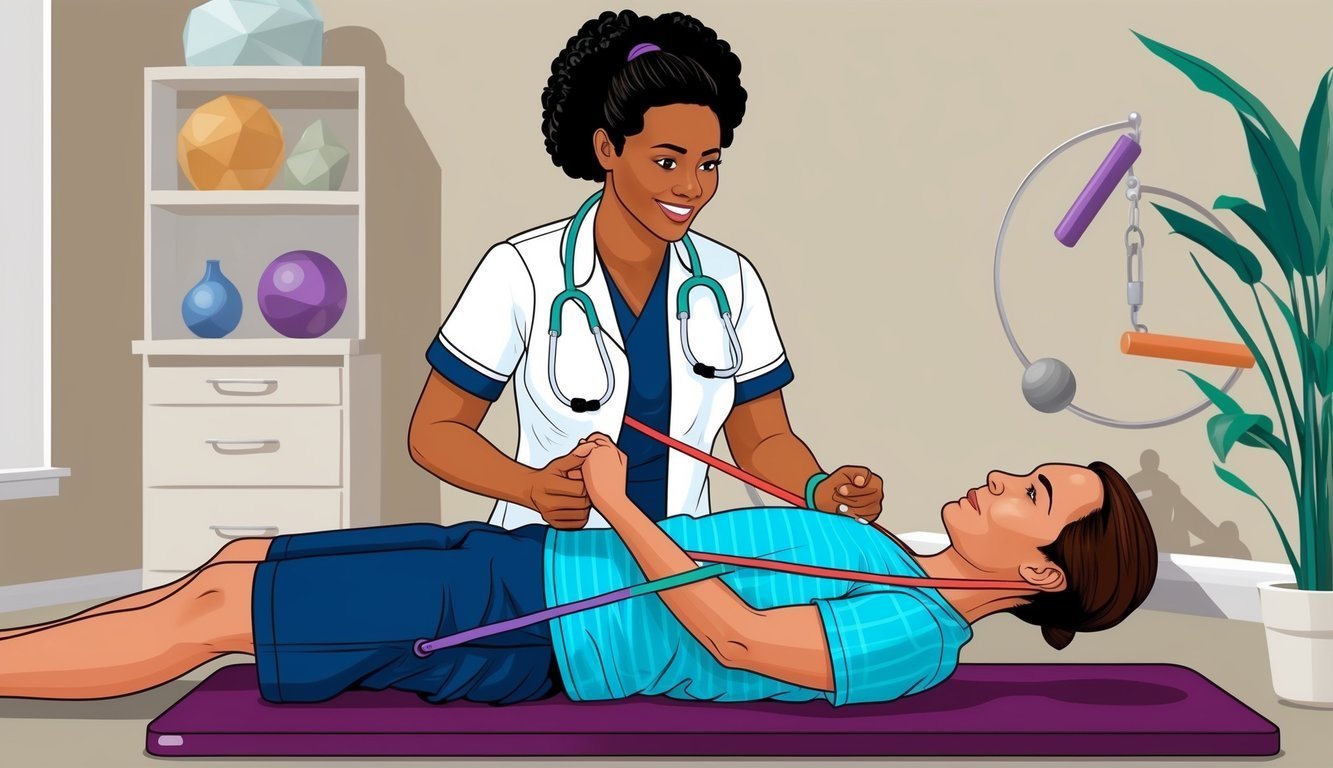As a physical therapy nurse, you play a vital role in helping patients recover from injury and manage chronic conditions. You support patient mobility and enhance their overall quality of life. This specialized nursing field requires a combination of clinical skills and compassionate care, allowing you to make a significant impact on each patient’s journey to recovery.
In this blog post, you’ll discover the essential duties of physical therapy nurses, the educational pathways needed to enter this profession, and the collaborative environment in which you will thrive.
Understanding these aspects will help you appreciate the value and challenges of working in this rewarding area of healthcare, where you can truly make a difference in your patients’ lives.
Whether you’re considering a career as a physical therapy nurse or are simply interested in the unique contributions of this role, you’ll find valuable insights that highlight what makes this profession so important in the healthcare landscape.
Key Takeaways
- Physical therapy nurses enhance patient care and mobility through specialized skills.
- Education and collaboration are key components to succeed in this field.
- This profession offers dynamic opportunities for professional development and growth.
Role and Responsibilities

As a physical therapy nurse, your role involves direct patient care, team collaboration, and the development of effective treatment plans. You will play a crucial part in improving patients’ mobility and overall health.
Patient Care and Rehabilitation
In your role, you will provide hands-on care to patients facing mobility issues or recovering from surgeries.
You will assess their physical condition, monitor their progress, and assist them with exercises designed to enhance strength and flexibility.
You will work specifically with individuals dealing with chronic illnesses or disabilities.
Your compassion and support are vital as you guide them through challenging rehabilitation processes.
You’ll educate patients and their families about therapy techniques, encouraging them to stay engaged in their recovery.
Collaboration with Healthcare Team
Collaboration with the healthcare team is essential.
You will work closely with physical therapists, occupational therapists, and physicians.
This teamwork ensures that all aspects of a patient’s care are addressed.
Regular communication allows you to share insights about patient progress and treatment efficacy.
By participating in interdisciplinary meetings, you can contribute valuable information regarding patients’ needs and expectations.
Effective collaboration helps create a comprehensive care plan tailored to each patient’s unique circumstances.
Development of Treatment Plans
In your position, you will help develop individualized treatment plans.
These plans should consider each patient’s specific mobility issues and rehabilitation goals.
You will assess their needs and design interventions that promote optimal recovery.
Treatment plans may include exercises, education on using assistive devices, and setting realistic goals for independence.
You will regularly review and adjust these plans based on patient progress.
Your role is essential to ensuring that your patients achieve the best possible outcomes in their rehabilitation journey.
Educational Pathways

To become a physical therapy nurse, you need to follow specific educational pathways.
This involves obtaining the proper nursing degree, pursuing physical therapy education, and acquiring the necessary licensing and certifications.
Nursing Degree Options
You have several options when it comes to obtaining a nursing degree.
The most common paths are:
- Associate Degree in Nursing (ADN): This typically takes two years and prepares you for entry-level nursing roles.
- Bachelor of Science in Nursing (BSN): A BSN usually requires four years and offers more advanced training. Many employers prefer BSN graduates for their comprehensive education.
Both degrees prepare you for the National Council Licensure Examination (NCLEX-RN), which you must pass to become a registered nurse.
Nursing education involves coursework in anatomy, pharmacology, and patient care.
It is important to choose an accredited program to ensure quality education.
Physical Therapy Education
After earning your nursing degree, you will need additional education focusing on physical therapy.
This includes pursuing a Doctor of Physical Therapy (DPT) degree.
The pathway generally includes:
- Completing a Bachelor’s Degree: While not always required to be in physical therapy, many students choose relevant fields such as kinesiology or exercise science.
- Doctor of Physical Therapy Program: This program usually lasts three years and includes both coursework and clinical experience.
Physical therapy education emphasizes anatomy, biomechanics, and therapeutic techniques.
It prepares you for specialized care in rehabilitation settings.
Consider researching programs that offer hands-on training in various clinical environments to enhance your skill set.
Licensing and Certifications
To practice as a physical therapy nurse, you must obtain appropriate licensing and certifications.
These steps include:
- NCLEX-RN Examination: After completing your nursing degree, passing this exam is crucial to becoming a licensed registered nurse.
- State Licensing: Each state has its own requirements. You will need to apply for a license in the state where you plan to work.
Additional certifications, such as those offered by the American Physical Therapy Association (APTA), may also be beneficial.
Continuing education is vital to maintain your license and stay updated on best practices in the field of physical therapy nursing.
Employment Landscape

The employment landscape for physical therapy nurses is shaped by factors like job availability, salary expectations, and opportunities for growth.
Understanding these elements can help you navigate your career more effectively.
Healthcare Jobs Market
The healthcare jobs market remains strong for physical therapy nurses.
According to recent data, outpatient physical therapy practices have seen a rise in job openings due to increased demand for services.
This growth reflects a robust labor market, making it a favorable time for job seekers.
Many facilities are expanding their staff to meet patient needs, resulting in greater job security.
You might find positions in hospitals, rehabilitation centers, and private practices.
Key areas of demand include:
- Outpatient clinics: They often need nurses for patient care.
- Rehabilitation facilities: Nurses play a vital role in recovery processes.
- Home health: Increasingly popular, this option provides care in patients’ homes.
Salary and Benefits
Salaries for physical therapy nurses are competitive and vary based on location and experience.
On average, you can expect a salary around $54.66 per hour, which totals about $9,480 monthly.
Nurses with over 20 years of experience can earn over $128,000 annually.
Your total compensation may also include:
- Health Insurance: Coverage for medical expenses.
- Retirement Plans: Options like 401(k) with employer matching.
- Paid Time Off: Vacation and sick leave.
Salaries are generally higher in urban areas where the cost of living is elevated, so consider location when evaluating job offers.
Career Advancement Opportunities
Career advancement is achievable for physical therapy nurses.
You can pursue additional certifications, such as becoming a certified orthopedic nurse.
These credentials can improve your employability and earning potential.
Continued education is valuable for professional development.
Many facilities support further training, which may include:
- Workshops: Enhance your skill set through hands-on training.
- Conferences: Network with professionals and learn about new industry trends.
- Online Courses: Flexible options to gain knowledge from home.
By actively seeking these opportunities, you position yourself for higher roles in the field and can play a more significant role in patient care and rehabilitation services.
Clinical Skills and Expertise

As a physical therapy nurse, your clinical skills and expertise play a vital role in patient recovery.
Your knowledge in pain management, mobility enhancement, and the effective use of rehabilitation equipment are essential for providing quality care.
Pain Management Techniques
Effective pain management is crucial in physical therapy.
You may use various techniques to help patients cope with their discomfort.
These may include:
- Medication Management: Administering prescribed pain medications and monitoring their effectiveness.
- Therapeutic Modalities: Implementing methods like heat, cold, or electrical stimulation to alleviate pain.
- Education: Teaching patients about self-management strategies, such as relaxation techniques and proper body mechanics.
Understanding the specific needs of each patient helps tailor your approach, ensuring optimal recovery outcomes.
Collaborating with physical therapists and occupational therapists can enhance pain relief strategies, leading to improved patient satisfaction.
Mobility Improvement Strategies
Improving patient mobility is a key focus in physical therapy.
To achieve this, you can implement various strategies:
- Functional Training: Guiding patients through everyday tasks to build strength and endurance.
- Assistive Devices: Educating patients on the proper use of walkers, canes, or braces to enhance their mobility.
- Balance Exercises: Incorporating exercises that focus on stability to prevent falls and boost confidence.
Your role may also involve developing personalized exercise plans that target specific mobility goals.
Regular assessments will help you adjust strategies to meet the patient’s evolving needs.
Use of Rehabilitation Equipment
The effective use of rehabilitation equipment is essential in your practice.
Knowledge of various tools helps you support patient recovery effectively.
Important equipment includes:
| Equipment | Purpose |
|---|---|
| Resistance Bands | Building strength through targeted exercises |
| Treadmills | Enhancing cardiovascular fitness and endurance |
| Parallel Bars | Providing support during balance and walking tasks |
Familiarizing patients with equipment and how to use it safely can empower them in their recovery journey.
Additionally, collaborating with physical and occupational therapists ensures a comprehensive approach to rehabilitation.
Interprofessional Collaboration
Interprofessional collaboration is essential for providing comprehensive patient care.
As a physical therapy nurse, you will regularly engage with a variety of healthcare professionals to ensure effective treatment plans and optimal patient outcomes.
Working alongside these specialists promotes teamwork and accountability in patient care.
Working with Physical Therapists
As a physical therapy nurse, you collaborate closely with physical therapists (PTs).
Your role includes assessing patient needs and communicating vital information to the PT.
Key tasks involve:
- Patient Evaluations: You help gather information on medical history and current health status to aid the PT in creating tailored treatment plans.
- Ongoing Observations: Regularly monitor patient progress during therapy sessions and report any changes to the PT promptly.
- Patient Education: Provide patients with instructions on exercises and activities to perform at home, reinforcing what they learn in therapy.
This partnership enhances coordination and helps patients achieve their rehabilitation goals more effectively.
Coordinating with Occupational Therapists
Coordination with occupational therapists (OTs) is equally important.
You will work with OTs to develop strategies that aid patients in regaining skills for daily living.
Essential points include:
- Holistic Assessment: Collaborate on patient evaluations, focusing on both physical and functional capabilities.
- Joint Treatment Plans: Work together to create comprehensive plans that address both mobility and daily functionality.
- Feedback Mechanism: Share insights about patients’ performance and difficulties, allowing OTs to adjust interventions as needed.
This teamwork ensures a more rounded approach to recovery, maximizing patients’ independence.
Engagement with Healthcare Professionals
Engagement with various healthcare professionals is crucial in your role.
This includes nurses, physicians, and specialists.
You can improve patient care by:
- Regular Meetings: Attend multidisciplinary team meetings to discuss patient progress and adjust care plans accordingly.
- Shared Documentation: Use electronic health records (EHR) to keep all team members informed about patients’ statuses and treatment updates.
- Cross-training Opportunities: Participate in training sessions with other healthcare professionals to enhance collaborative skills and knowledge.
By fostering these interactions, you contribute to a supportive environment that encourages holistic patient care and positive health outcomes.
Frequently Asked Questions
In this section, you’ll find important details about transitioning into a physical therapy nursing career, required education, job responsibilities, salary comparisons, and employment settings.
You’ll also learn about certifications that can enhance your qualifications in this field.
How can one transition from nursing to a physical therapy career?
To transition from nursing to a physical therapy career, you may build on your current qualifications by gaining additional training.
Pursuing certifications or further education in physical therapy is a great way to start.
What educational qualifications are necessary to become a physical therapy nurse?
To become a physical therapy nurse, you typically need to have an active registered nursing (RN) license.
Many positions also require specific training or a degree in rehabilitation or physical therapy nursing to meet the unique needs of patients.
What are the primary responsibilities of a nurse in a physical therapy setting?
In a physical therapy setting, your main responsibilities include assessing patient conditions, administering care as directed by physical therapists, and assisting with exercises.
You also manage patient education to help improve their movement and daily function.
How does the salary of a physical therapy nurse compare to that of a physiotherapist?
The salary of a physical therapy nurse generally ranges based on experience.
As reported, physical therapy nurses earn about $54.66 per hour, while physiotherapists may have higher earnings depending on their education and specialization.
A physical therapy nurse can earn around $128,560 annually with enough experience.
In what type of facilities can a physical therapy nurse find employment?
You can find employment as a physical therapy nurse in various settings, including hospitals, rehabilitation centers, clinics, and home health agencies.
Each facility offers different opportunities based on patient needs.
Are there any specialized certifications required for nurses working in physical therapy?
Specialized certifications can enhance your skills and marketability.
Certifications in areas such as wound care or rehabilitation nursing can be beneficial.
Some of these certifications are not always required.
You should also check with professional nursing organizations for specific certification programs.

